12-Week flea Protection for Dogs2,8
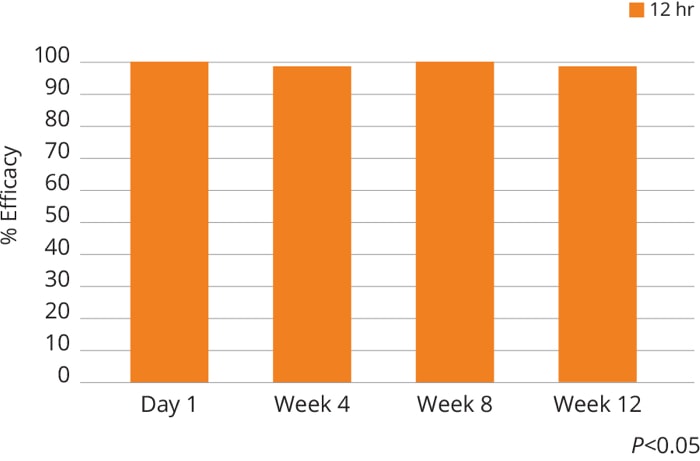
- Erythema
- Papules
- Crusts
- Alopecia
- Scales
- Excoriation
Frontline® Plus is a registered trademark of Merial.

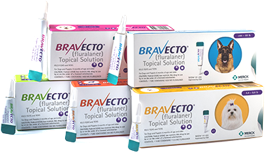
A fast-acting flea and tick protection in an easy-to-administer topical solution for dogs. Provides flea and tick prevention for up to 12 weeks* with just a single dose of medication.
Bravecto Topical Solution for Dogs is approved for pregnant, breeding, and lactating dogs.2 Bravecto (fluralaner) is also approved for use in dogs 6 months of age or older who weigh at least 4.4 pounds.2
INDICATIONS:
Bravecto Topical Solution for Dogs kills adult fleas and is indicated for the treatment and prevention of flea infestations (Ctenocephalides felis) and the treatment and control of tick infestations [Ixodes scapularis (black-legged tick), Dermacentor variabilis (American dog tick), and Rhipicephalus sanguineus (brown dog tick)] for 12 weeks in dogs and puppies 6 months of age and older, and weighing 4.4 pounds or greater.
Bravecto (fluralaner) is also indicated for the treatment and control of Amblyomma americanum (lone star tick) infestations for 8 weeks in dogs and puppies 6 months of age and older, and weighing 4.4 pounds or greater.

Toy dogs
4.4-9.9 LB
112.5 MG

Small dogs
>9.9-22.0 LB
250 MG

Medium dogs
>22.0-44.0 LB
500 MG

Large dogs
>44.0-88.0 LB
1,000 MG

Extra-large dogs
>88.0-123.0† LB
1,400 MG
One application per weight band2
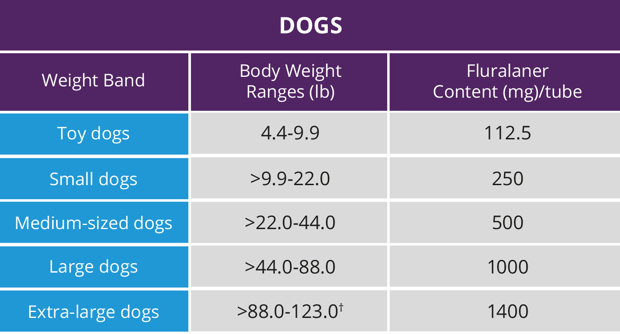
†Dogs over 123.0 lb. should be administered the appropriate combination of tubes.


Frontline® Plus is a registered trademark of Merial.
No items to show.

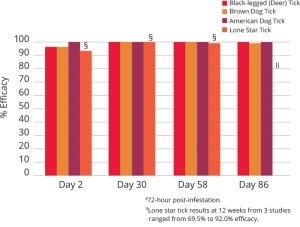
Bravecto efficacy was evaluated in a 12-week in a clinical field study. Results found that Bravecto has a ≥93.3% effectiveness for 12 weeks against Ixodes scapularis (black-legged tick), Dermacentor variabilis (American dog tick), and Rhipicephalus sanguineus (brown dog tick) and ≥90% effectiveness for 8 weeks against Amblyomma americanum (lone star tick).2 Bravecto was also shown to reduce exposure to ticks, which can carry tick-borne diseases.
No items to show.

New York
“The 12-week* protection of Bravecto provides less stress and less complications for pet owners.”

Louisiana
“Bravecto is easy to offer to clients and administer, making pet owners happy.”

California
“The benefits of highly effective and easy-to-apply 12-week* protection for cats.”
No items to show.
DOGS
Bravecto has been approved for use in breeding, pregnant, and lactating female dogs.1,2 Bravecto is safe to use and efficacious in adult dogs and puppies over 6 months of age and weighing 4.4 lb. or greater.1,2 It has been tested and found safe in puppies at least 8 to 9 weeks of age at 5x the clinical dose.1,2,17 No adverse effects with Bravecto Chew for Dogs in MDR-1 gene-deficient collies at 3x the recommended dose.18
CATS
Bravecto is safe to use and efficacious in adult cats and kittens over 6 months of age and weighing 2.6. lb. or greater.3 It has been tested and found safe in kittens at least 11 to 13 weeks of age at 5x the clinical dose.3
PROVEN SAFETY
No known contraindications for Bravecto Chew for Dogs and Bravecto Topical Solution for Dogs and Cats.1-3
No problems reported in field trials in dogs and cats that received Bravecto concurrently with other commonly used medication.1-3
Bravecto has not been shown to be effective for 12 weeks1 duration in puppies or kittens less than 6 months of age.
Bravecto Chew: The most common adverse reactions recorded in clinical trials were vomiting, decreased appetite, diarrhea, lethargy, polydipsia, and flatulence. Bravecto is not effective against lone star ticks beyond 8 weeks of dosing.
Bravecto Topical Solution for Dogs: The most common adverse reactions recorded in clinical trials were vomiting, hair loss, diarrhea, lethargy, decreased appetite, and moist dermatitis/rash. Bravecto is not effective against lone star ticks beyond 8 weeks of dosing. For topical use only. Avoid oral ingestion. Use caution in dogs with a history of seizures. Seizures have been reported in dogs receiving fluralaner, even in dogs without a history of seizures.
Bravecto Topical Solution for Cats: The most common adverse reactions recorded in clinical trials were vomiting, itching, diarrhea, hair loss, decreased appetite, lethargy, and scabs/ulcerated lesions. Bravecto is not effective against American dog ticks beyond 8 weeks of dosing. For topical use only. Avoid oral ingestion. The safety of Bravecto has not been established in breeding, pregnant or lactating cats. Use caution in cats with a history of neurologic abnormalities. Neurologic abnormalities have been reported in cats receiving Bravecto, even in cats without a history of neurologic abnormalities.
In field studies and safety studies, no dogs or cats experienced serious adverse events.1-3,7,8
In margin of safety study, kittens and puppies were dosed at three 8-week intervals.
Contact us for more information about Bravecto for your hospital.
We’ll answer any questions, and help you start prescribing Bravecto for the dogs and cats in your care.
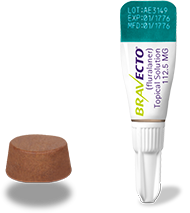

For technical assistance or to report a suspected adverse drug reaction, contact Merck Animal Health at 1-800-224-5318.
This site is intended for veterinary professionals. Vist our website for pet parents.
*BRAVECTO kills fleas and prevents flea infestation. Bravecto Chew and Bravecto Topical for Dogs kills ticks (black-legged tick, American dog tick, and brown dog tick) for 12 weeks and also kills lone star ticks for 8 weeks. Bravecto Topical for Cats kills ticks (black-legged tick) for 12 weeks and American dog ticks for 8 weeks.
IMPORTANT SAFETY INFORMATION:
BRAVECTO has not been shown to be effective for 12-weeks’ duration in puppies or kittens less than 6 months of age. Fluralaner is a member of the isoxazoline class. This class has been associated with neurologic adverse reactions including tremors, ataxia, and seizures. BRAVECTO Chew: The most commonly reported adverse reactions include vomiting, decreased appetite, diarrhea, lethargy, polydipsia, and flatulence. BRAVECTO is not effective against lone star ticks beyond 8 weeks of dosing. Seizures have been reported in dogs receiving isoxoline class drugs, even in dogs without a history of seizures. Use with caution in dogs with a history of seizures or neurologic disorders. BRAVECTO Topical Solution for Dogs: The most commonly reported adverse reactions include vomiting, hair loss, diarrhea, lethargy, decreased appetite, and moist dermatitis/rash. Bravecto is not effective against lone star ticks beyond 8 weeks of dosing. For topical use only. Avoid oral ingestion. Seizures have been reported in dogs receiving isoxoline class drugs, even in dogs without a history of seizures. Use caution in dogs with a history of seizures or neurologic disorders. BRAVECTO Topical Solution for Cats: The most commonly reported adverse reactions include vomiting, itching, diarrhea, hair loss, decreased appetite, lethargy, and scabs/ulcerated lesions. BRAVECTO is not effective against American dog ticks beyond 8 weeks of dosing. For topical use only. Avoid oral ingestion. The safety of BRAVECTO has not been established in breeding, pregnant and lactating cats. Neurologic adverse reactions have been reported in cats receiving isoxazoline class drugs, even in cats without a history of neurologic disorders. Use with caution in cats with a history of neurologic disorders.
References:
1. Bravecto Chew for Dogs [prescribing information]. Madison, NJ: Merck Animal Health; 2014.
2. Bravecto Topical Solution for Dogs [prescribing information]. Madison, NJ: Merck Animal Health; 2016.
3. Bravecto Topical Solution for Cats [prescribing information]. Madison, NJ: Merck Animal Health; 2016.
4. Rohdich N, Roepke RKA, Zschiesche E. A randomized, blinded, controlled and multi-centered field study comparing the efficacy and safety of Bravecto™ (fluralaner) against Frontline™ (fipronil) in flea- and tick-infested dogs. Parasites & Vectors. 2014;7:83.
5. Beck S, Schein E, Baldermann C, von Samson-Himmelstjerna G, Kohn B. Tick infestation and tick prophylaxis in dogs in the area of Berlin/Brandenburg – results of a questionnaire study. Berl Munch Tierarztl Wochenschr. 2013;126(1-2):69-76.
6. Kidd L, Breitschwerdt EB. Transmission times and prevention of tick-borne diseases in dogs. Compend Contin Educ Pract Vet. 2003;(25)10:742-751.
7. Freedom of Information Summary, NADA 141-426. Approved May 15, 2014.
8. Freedom of Information Summary, NADA 141-459. Approved 2016.
9. Gassel M, Wolf C, Noack S, Williams H, Ilg T. The novel isoxazoline ectoparasiticide fluralaner: selective inhibition of arthropod γ-aminobutyric acid- and L-glutamate-gated chloride channels and insecticidal/acaricidal activity. Insect Biochem Mol Biol. 2014;45:111-124.
10. Williams H, Demeler J, Taenzler J, Roepke RK, Zshiesche E, Heckeroth AR. A quantitative evaluation of the extent of fluralaner uptake by ticks (Ixodes ricinus, Ixodes scapularis) in fluralaner (Bravecto™) treated vs. untreated dogs using the parameters tick weight and coxal index. Parasites & Vectors. 2015;8:352.
11. Taenzler J, Wengenmayer C, Williams H, et al. Onset of activity of fluralaner (Bravecto™) against Ctenocephalides felis on dogs. Parasites & Vectors. 2014;7:567.
12. Meadows C, Guerino F, Sun F. A randomized, blinded, controlled USA field study to assess the use of fluralaner tablets in controlling flea infestations. Parasites & Vectors. 2014;7:375.
13. CAPCvet.org. Accessed July 5, 2016.
14. Data on File, Merck Animal Health.
15. Taenzler J, Liebenberg J, Roepke RKA, Heckeroth AR. Prevention of transmission of Babesia canis by Dermacentor reticulatus ticks to dogs treated orally with fluralaner chewable tablets (Bravecto™). Parasites & Vectors. 2015;8:305.
16. Wengenmayer C, Williams H, Zschiesche E, et al. The speed of kill of fluralaner (Bravecto™) against lxodes ricinus ticks on dogs. Parasites & Vectors. 2014;7:525.
17. Walther FM, Allan MJ, Roepke RKA, Nuernberger MC. Safety of fluralaner chewable tablets (Bravecto™), a novel systemic antiparasitic drug, in dogs after oral administration. Parasites & Vectors. 2014;7:87.
18. Walther FM, Allan MJ, Roepke RKA, Nuernberger MC. Safety of fluralaner, a novel systemic antiparasitic drug, in MDR1(-/-) collies after oral administration. Parasites & Vectors. 2014;7:86.
19. Burgio et al. Parasites & Vectors (2016) 9:626.
20. Meadows et al, Parasites & Vectors, (2017) 10:36.
21. Meadows et al, Parasites & Vectors, (2017) 10:37.